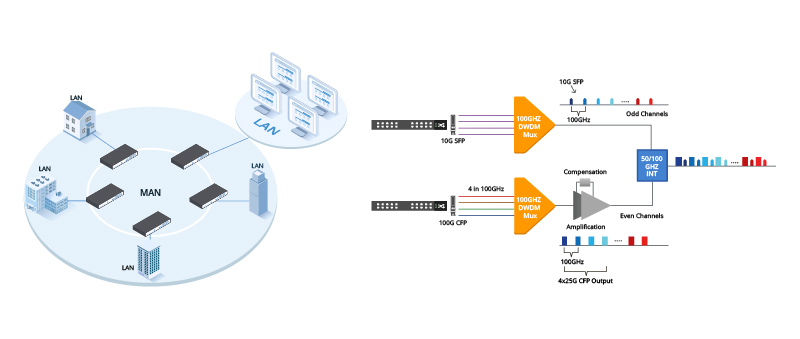100G Coherent Optics Solution for Metro & Core Networks
Coherent optics has been a widespread technology that solves the capacity problems many network operators face. While metropolitan area networks (MAN) and core networks are the typical applications where coherent optics are utilized. How does 100G coherent optics evolve? And how does this technology impact MAN & core networks? This article will provide information about 100G coherent optics in metro and core networks.
Evolution of 100G Coherent Optics
100G optics are not the new norm in 2022, since we have seen much higher speeds highlighted over and over again by various forecast industries and optics vendors. 400G coherent optics have been noticed on the market, but, we can not deny that 100G occupies most of the market today.
As early as 2016, 10G had reached its scaling limits in metro networks and carriers began to turn 100G to focus more on the metro network, which is the most applicable scenario considering the price and need. At the time that 100G Ethernet met both the requirements, meanwhile, the high bandwidth would satisfy the 40% traffic growth per year. Though coherent 100G witnesses competing against direct-detect 100G interfaces based on PAM4, it still shows its advantages in some particular scenarios.
Until the ratification of IEEE 802.3ba in 2011, the carrier IP backbone network had entered the 100G platform era. Since then, the 100G coherent platform has become widely integrated into metro and backbone networks, and 100G routers and coherent optics are put into use for metro and core.
100G coherent optics were designed for the 100G DWDM long-haul transmission. As the "future of high-speed DWDM", coherent optics leverage QAM/DPSK to carry multiple symbols per bit. Nowadays there are 100G/200G coherent optics in the CFP and CFP2 form factor, supporting distances up to 1000km/2000km. It is ideal for line-side trunk DWDM data center interconnects, metro carriers and regional/long-haul applications.
100G Coherent Optics Scenario in Metro & Core Networks
The application of DWDM in metro networks and in core networks are not exactly the same because metro networks do not need to reach as far as core networks and the distance impairments in metro networks are prone to be less severe. But the network infrastructure equipment used on the two networks has the same features: DWDM-based.
A typical metro network scenario relies on multiplexing multiple 10Gb/s or 40Gb/s onto a single fiber pair. Given that 100Gb/s service has been implemented to the legacy 10G system, with the help of the 100G DWDM Mux, 10G from the line card can be integrated.
To maximize the available bandwidth while controlling the cost as low, adding 100G coherent CFP transceivers can be an optimal method, which expands the transmission reach to a longer distance. 100G DWDM Mux combines all the services and equipment for dispersion compensation and amplification is installed. When the bandwidth is exhausted, it is also possible to replace the legacy 10Gb/s channels with 100G.

Future of 100G Coherent Optics
With the growth in the applications such as 5G, cloud service, video streaming, etc, the steps of 100G coherent is not limited to core and metro networks. As the last ten years have witnessed the application of 100G coherent transceivers in long-haul transmissions, 100G coherent optics is also expected to expand to edge and access networks. And now it's time. Acacia Communications has brought the new 100G transceiver type to the market—100G coherent QSFP-DD, aimed at point-to-point edge and access network applications.
At present, 400G application in core network is not an easy thing. Cost is still the problem no one can overlook, let alone the deficiencies in the terms of transmission performance currently. While for metro networks, 400G has built a complete industry chain and technical solutions. Maybe in the future, we'll see coherent covers more network types and 100G coherent optics provides more simplicity and scalability to the next-generation edge and access networks.
You might be interested in
Email Address

-
PoE vs PoE+ vs PoE++ Switch: How to Choose?
Mar 16, 2023



















